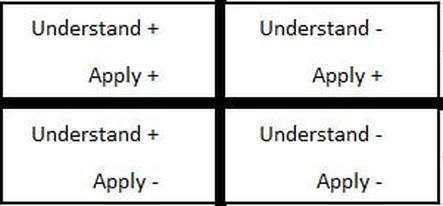 "If we don't battle to the death, they will kill us both" "If we don't battle to the death, they will kill us both" Originally published as The Cause, Cost and Countermeasure to Conflict in an Organization in The Project Management Times By Jon Isaacson If you have dysfunction in your team, the cost may be higher than you want to admit but the cure may also be closer than you realize. Frustration in the workplace, does such a thing exist? In a recent article in Forbes magazine, researchers discussed the primary sources of disgruntlement within organizations. According to the study, most employees noted that they were frustrated by personality differences and incompetence in their co-workers. This is not news to anyone who has worked in an organizational setting, one human plus one human will eventually equal conflict. The potential for conflict, as well as the intensity and duration, are compounded by the number of humans added to the equation. More people, more problems. What is interesting about the Forbes article is that upon further investigation there was an underlying source which contributed to the environment of dysfunction, “In fact, teams having conflict had much higher levels of ambiguity in three categories of work: their team’s goals, roles, and procedures. So, while it is very human to assign personal motive and blame in times of trouble, there isn’t really anything personal about the core of workplace conflict. If you back up and look at the facts, a lack of clarity is what’s truly to blame.” (Wakeman, 2015) The need for clarity is foundational to functionality and trust within an organization. Where there is a lack of clarity, there will be conflict. Office drama is costly, CPP Inc. performed a study in 2008 which discovered that employees in the United States spent 2.8 hours per week dealing with conflict which CPP estimated as costing over $359 billion in paid hours or the equivalent of 385 million working days (Lawler, 2010). Every business understands the need to watch the bottom line, so why are mangers unwilling to recognize the high cost of conflict? Think of it, if every employee in your office could increase engagement and efficiency by 7% by only changing one element, wouldn’t that be something a wise leader would be more intentional about? Recognize the cost of inaction. Managers spend much of their time putting out fires, and yet our discussion to this point has demonstrated that the cure for dysfunction may be closer that you think. By understanding the cost of conflict, we recognize the value of investing in practices that will help our organization to identify and address these hot beds of discordance within our teams. Realize the need to eliminate the blame game. When employees focus on blaming each other, too often managers are happy to allow them to target their ire upon each other rather than dealing with the core of these issues which creates a negatively recurring cycle. As noted by the author in a prior article - how leaders respond to conflicts can either reinforce cultural values that strengthen the team, or they can respond in ways that destroy morale (Isaacson, 2016). Reduce conflict by creating clarity. If the research from Wakeman and her team as outlined in Forbes is accurate, then leaders can make a significant reduction in interpersonal conflict by being more intentional about organizational clarity. As a leader, you can alleviate friction between team members by being more clear about team goals, roles, and procedures as quoted above. If we can sense the frustration in the organization and we can calculate the deep costs, we should be proactive in working towards long-term solutions. Often inaction is caused by an inability to identify the causes or formulate an effective plan, but now that these have been brought to light the only question left is whether we will be intentional about getting into the mix to make the magic happen. There are no shortcuts when working with interpersonal dynamics but progress is attainable through the countermeasures for the conflict we have discussed. References Wakeman, Cy (2015, June 22) The number 1 source of workplace conflict, and how to avoid it. Forbes. Retrieved fromhttp://www.forbes.com/sites/cywakeman/2015/06/22/the-1-source-of-workplace-conflict-and-how-to-avoid-it/#32a27f89126e Lawler, Jennifer (2010, June 21) The real cost of workplace conflict. Entrepreneur. Retrieved fromhttps://www.entrepreneur.com/article/207196 Isaacson, Jon (2016, July 11) Eliminating blame in your organization. Retrieved from http://izvents.weebly.com/words/eliminating-blame-in-your-organization
0 Comments
 Define and apply discipline according to your values Define and apply discipline according to your values The guidelines for discipline are the same as the guidelines for leadership they are just applied in a different way as each situation requires examination. Our work in roles of leadership boil down to creating a culture of clarity, consistency and accountability. As we build clarity around our vision, values and the processes that will help our teams and individuals to succeed there will be those who push back on those changes. Resistance is healthy when individuals are discovering whether they can buy into a vision and contribute to the culture, the discernment for a leader needs to be applied to whether the push back is part of a process or embedded in a person’s character. Does the situation of resistance show someone who has made a mistake, someone who is processing the changes or someone who has decided to be an obstacle to progress? Contributing to a cultural change requires a commitment of the brain and the body, to understand the vision and to put the values into practice. Understanding and Application have four basic quadrants:  An individual who understands the vision and has chosen to follow and apply the process (Understand + / Apply +). Even in this sector of people, there are those who push back but who ultimately contribute to the team. Individuals work through changes in unique ways and some may be processors who take a bit more time to grasp and engage the details even while they are on board with the overall direction. Those individuals who understand and are applying the vision need to be empowered as partners to help spread the message throughout the team. Not everyone is going to respond to you as a leader and your style in the same way, within this group of early adopters find ways to leverage that momentum to help bring team members who are struggling to understand and/or apply into the fold. An individual who doesn’t understand the vision but has chosen to give the process a chance (Understand - / Apply +). Some people trust the leader but don’t quite get the process or vice versa, they understand the goal of what the team is trying to achieve but they don’t yet trust the leader (the next quadrant). There are many people who are good employees but may not connect with a particular leader or may not be a good long term fit for a culture, of course the best combination is someone who gets in and is passionate about moving the mission forward but don’t overlook those who didn’t understand the vision after one power point presentation. An individual who understands the vision but has not chosen to follow and apply the process (Understand + / Apply -). This group sees the vision and can wrap their mind around it but either they don’t agree with the direction or they don’t trust the leaders or the process. Often a seasoned employee who has seen many vision and values changes may be in this camp, “I’ve seen this before, this will last three months.” There are also individuals who are loyal to the company but believe strongly in the good ol’ days as being the best days and like many are resistant to change. The question is whether these individuals can be won over and will take that positive sense of loyalty and buy into the new direction. Leaders have their work cut out to discern whether there is value in investing in winning these team members over. Often those who are the most resistant initially but are won over will be some of your strongest proponents in the future. An individual who does not understand the vision and has chosen not to apply the process (Understand - / Apply -). While these current team members likely aren’t a good fit for the long term, a leader should dig beneath the surface to determine whether individuals aren’t buying in because they are against the process or they are some combination of the two prior quadrants. Often those who were strong “leaders” from within the team for a prior culture or process will be resistant to changes because there is fear about their position within the new direction. For those who can change there is a role on the team, for those who cannot we can have discussions about assisting them to find a team where their values are a better fit. When you are in a leadership role and are working towards a new direction or are taking over a team that is new to you, there will always be a level of resistance. Push back is natural, it is likely part of why you were able to develop yourself into a position as a leader. Growth as an organization does not happen unless someone is willing to say – what we are doing either isn’t working or will not be sustainable over time. If we want different results we will have to do things differently. The key as a leader is to work towards building clarity in the vision, consistency in the pursuit and accountability in the culture. You cannot forge forward without your team unless you want to be a company of one forever, you must learn to communicate and inspire individuals to understand and apply the vision (Read more on developing Emotional Intelligence or EQ - HERE). As you do so, understand that not all resistance is negative, much of it is part of the process and working through it will help you develop into a stronger leader and your team as a stronger unit. Leadership is leading. |
AuthorThoughts on personal and professional development. Jon Isaacson, The Intentional Restorer, is a contractor, author, and host of The DYOJO Podcast. The goal of The DYOJO is to help growth-minded restoration professionals shorten their DANG learning curve for personal and professional development. You can watch The DYOJO Podcast on YouTube on Thursdays or listen on your favorite podcast platform.
Archives
March 2023
Categories
All
<script type="text/javascript" src="//downloads.mailchimp.com/js/signup-forms/popup/unique-methods/embed.js" data-dojo-config="usePlainJson: true, isDebug: false"></script><script type="text/javascript">window.dojoRequire(["mojo/signup-forms/Loader"], function(L) { L.start({"baseUrl":"mc.us5.list-manage.com","uuid":"b9016446bd3c6a9f0bd835d4e","lid":"83282ffb9e","uniqueMethods":true}) })</script>
|
Jon Isaacson |
Connect. Collaborate. Conquer.
© COPYRIGHT 2015. ALL RIGHTS RESERVED.
|



 RSS Feed
RSS Feed